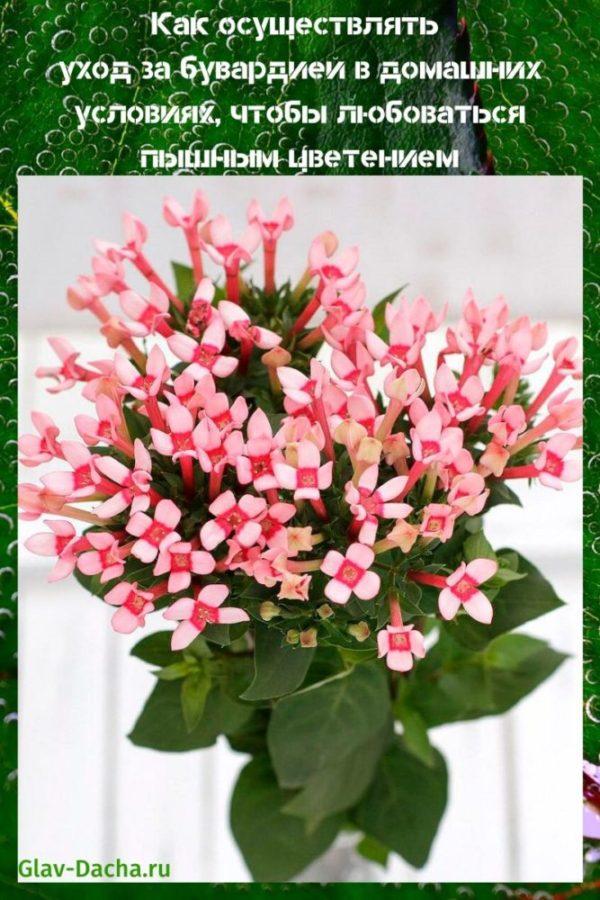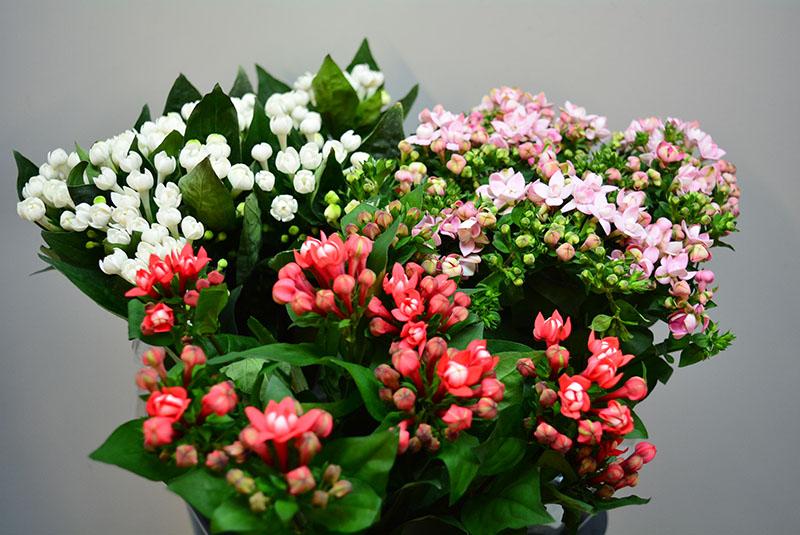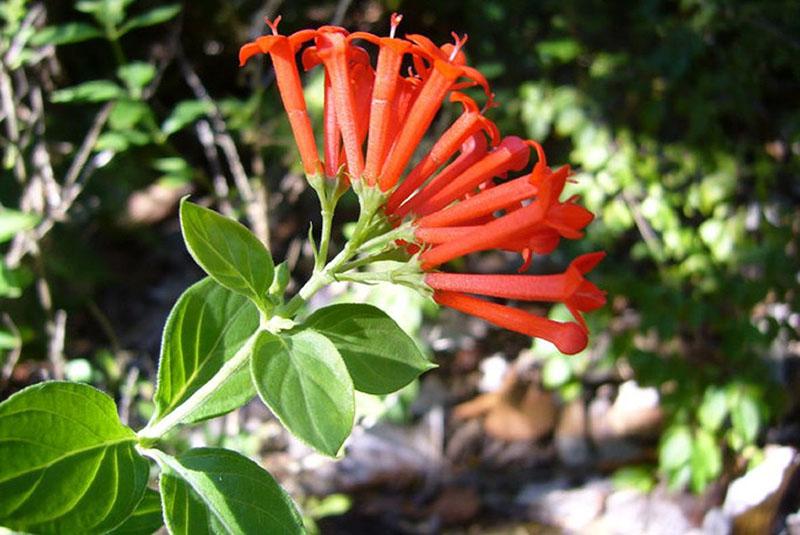How to care for a bouvardia at home to admire the lush bloom
 Lovers of abundantly flowering indoor crops with lush green mass often use evergreen shrubs to decorate their collection. These include bouvardia. At the same time, caring for bouvardia at home does not require significant effort from a grower. To obtain a strong, healthy plant, the necessary agrotechnical measures should be observed, transplanted in time and protected from diseases and pests.
Lovers of abundantly flowering indoor crops with lush green mass often use evergreen shrubs to decorate their collection. These include bouvardia. At the same time, caring for bouvardia at home does not require significant effort from a grower. To obtain a strong, healthy plant, the necessary agrotechnical measures should be observed, transplanted in time and protected from diseases and pests.
Varieties of bouvardia for growing at home

They all differ in size, shade and shape of flowers:
- Smooth-flowered (Bouvardia longiflora). An evergreen bush that grows up to 60 cm in height. 3 leaves are collected in whorls. Perhaps their location in the sockets is opposite. A dense corymbose inflorescence is formed at the edge of the shoot. The flowers themselves are tubular with four petals, grow up to 2 cm in length. The color of the petals is salmon on the inside and scarlet on the outside.

- Long-flowered (Bouvardia longiflora). The height of the bush reaches 90 cm. The variety is used to create flower bouquets and compositions. The leaves of the long-flowered culture are slightly oblong, opposite. The flowers are densely arranged, they are formed in the axils of the apical leaves. White or light pink petals exude a pleasant scent.

- Household (Bouvardia domestica). The most famous and common variety among indoor florists is pink bouvardia. Its shoots grow up to 70 cm in height, dark green oval-shaped leaves are formed on them, slightly pointed towards the edge. Flowers can be of various shapes and shades. The color varies from pale pink to crimson depending on the selection. In addition, varieties with double petals have been bred.

- Jasminiflora (Bouvardia jasminiflora). A dwarf variety with shoots about 60 cm long. A characteristic feature is flowering in winter. The jasmine-flowered bouvardia has white flowers in shape and smell that resemble jasmine inflorescences.

Caring for bouvardia at home
 Representatives of the Madder family are rare guests in the collections of flower growers, but this does not mean that bouvardia is a very whimsical plant. Simple and clear rules for caring for blooming and exotic crops are applicable to it.
Representatives of the Madder family are rare guests in the collections of flower growers, but this does not mean that bouvardia is a very whimsical plant. Simple and clear rules for caring for blooming and exotic crops are applicable to it.
In order for the bouvardia flower to please the owner, it must be moistened in a timely manner, ensure proper lighting, and also do not forget about feeding.
Lighting and temperature of content
 Bouvardia is a representative of the tropical flora and loves the sun. She needs to provide a lot of light. This is especially true for periods of active vegetation and flowering. But it is advisable to protect the flower from the midday sun rays by shading. The plant is best suited for a spacious window sill facing the south side of the house.
Bouvardia is a representative of the tropical flora and loves the sun. She needs to provide a lot of light. This is especially true for periods of active vegetation and flowering. But it is advisable to protect the flower from the midday sun rays by shading. The plant is best suited for a spacious window sill facing the south side of the house.
 Bouvardia is not demanding on the ambient temperature and develops well at home. In summer, the ideal setting is 23-25 ° C.As soon as the air warms up outside, you can take the flower out to the balcony or yard. In winter, with the onset of the resting phase, the temperature can be reduced to 12-14 ° C. However, the tropical plant does not tolerate the cold: lowering the mercury column of the thermometer below 10 ° C will lead to the leaves freezing and falling off.
Bouvardia is not demanding on the ambient temperature and develops well at home. In summer, the ideal setting is 23-25 ° C.As soon as the air warms up outside, you can take the flower out to the balcony or yard. In winter, with the onset of the resting phase, the temperature can be reduced to 12-14 ° C. However, the tropical plant does not tolerate the cold: lowering the mercury column of the thermometer below 10 ° C will lead to the leaves freezing and falling off.
Air humidity and irrigation features
Despite the fact that this is a tropical plant, it easily tolerates dry air. In this regard, home care for the bouvardia consists in periodic rinsing in the shower. The procedure is optional, but it will help to refresh the flower and wash off the dust accumulated on them from the leaves.
During the active growing season, as well as flowering bouvardia, daily watering is required:
- It is necessary to moisten it with small portions of water, pouring it under the root.
- Care must be taken that the soil does not dry out, but it is not overly saturated with liquid.
- Excess moisture can provoke the development of diseases or lead to decay of the root system.
Watering is necessary with settled water at room temperature.
Soil selection, fertilization
 Any soil is suitable for tropical "exotic". The main condition is that it must be vapor permeable and saturated with micronutrients. For cultivation, you can take a ready-made substrate for flowering plants or prepare a soil mixture yourself.
Any soil is suitable for tropical "exotic". The main condition is that it must be vapor permeable and saturated with micronutrients. For cultivation, you can take a ready-made substrate for flowering plants or prepare a soil mixture yourself.
In the latter case, sod, peat and leafy soil is mixed in proportions 4: 2: 1, where part of the sand is added to loosen it. A drainage layer must be laid on the bottom: crushed perlite or vermiculite.
 An indoor plant is sensitive to a lack of trace elements in the soil. In order for the bouvardia to please the owner with lush greenery and abundant flowering, it must be fed with a complex mineral fertilizer. Trace elements are introduced along with watering once every 2 weeks. During the dormant period, it is not necessary to feed the plant.
An indoor plant is sensitive to a lack of trace elements in the soil. In order for the bouvardia to please the owner with lush greenery and abundant flowering, it must be fed with a complex mineral fertilizer. Trace elements are introduced along with watering once every 2 weeks. During the dormant period, it is not necessary to feed the plant.
Pruning and transplanting bouvardia
 Breeders recommend periodically pruning the shoots. Do this to form a lush green mass and abundant flowering. Pruning is performed on an annual plant. The tops of the shoots are pinched at him, limiting their further growth. In a two-year-old bouvardia, the stems are cut in half in the fall.
Breeders recommend periodically pruning the shoots. Do this to form a lush green mass and abundant flowering. Pruning is performed on an annual plant. The tops of the shoots are pinched at him, limiting their further growth. In a two-year-old bouvardia, the stems are cut in half in the fall.
 The pot life is short. The peak of decorativeness is in the second year. On the third, bouvardia will not delight the owner with lush flowering and may not release peduncles at all. Nobody has been growing tropical exotic plants for more than two years, but in the spring, after the first year of life, the plant must be transplanted into a larger pot. The procedure is performed by the transshipment method with the addition of a fresh portion of soil.
The pot life is short. The peak of decorativeness is in the second year. On the third, bouvardia will not delight the owner with lush flowering and may not release peduncles at all. Nobody has been growing tropical exotic plants for more than two years, but in the spring, after the first year of life, the plant must be transplanted into a larger pot. The procedure is performed by the transshipment method with the addition of a fresh portion of soil.
For the jasmine-flowered variety, it is advisable to organize supplementary lighting with phytolampsto compensate for the lack of sunlight.
Diseases and pests
 Caring for bouvardia at home means taking preventive measures aimed at preventing the appearance of diseases or pests. Despite the fact that the culture is resistant to parasites, during the hot period it can be attacked by aphids or spider mites. Rinsing under a warm shower and treatment with soapy water will help to cope with the pest. In addition, you can use insecticidal preparations at the dosage recommended by the manufacturer.
Caring for bouvardia at home means taking preventive measures aimed at preventing the appearance of diseases or pests. Despite the fact that the culture is resistant to parasites, during the hot period it can be attacked by aphids or spider mites. Rinsing under a warm shower and treatment with soapy water will help to cope with the pest. In addition, you can use insecticidal preparations at the dosage recommended by the manufacturer.
When treating a plant with pesticides, it is necessary to prevent them from entering the ground. For this, the earthen lump is covered with a material that does not allow water to pass through.
If the leaves turn yellow or look unhealthy, this indicates a lack of nutrients or poor water quality for humidification. In the first case, the flower is fertilized with complex fertilizers containing iron. When bouvardia reacts negatively to water, it should be watered with settled liquid without chlorine and other chemicals.
With excessive moisture, the flower may develop root rot. In this case, it will be very difficult to save the plant. You can try to transplant it into another pot, but it is better to play it safe and cut the cuttings from the bush for further breeding.
Reproduction bouvardia
 The short lifespan of the bouvardia necessitates frequent reproduction.
The short lifespan of the bouvardia necessitates frequent reproduction.
Breeders use 3 ways:
- By dividing the bush.
- By transplanting a root fragment.
- Rooting of the apical cutting.
The first 2 methods are rarely used due to their low efficiency. Considering that the decorative value of bouvardia occurs only in the second year, dividing an adult bush does not make sense. Reproduction by a root process will allow a new plant to grow, but for novice florists, the procedure often ends in failure.
 The most effective breeding method is with an apical cuttings. The material is used after trimming or specially prepared. For breeding, a shoot 10 cm long is prepared. 2-3 internodes should remain on it. You can put the stalk in a container of water or immediately plant it in a small pot. The first option is more reliable and you can visually monitor the development of roots.
The most effective breeding method is with an apical cuttings. The material is used after trimming or specially prepared. For breeding, a shoot 10 cm long is prepared. 2-3 internodes should remain on it. You can put the stalk in a container of water or immediately plant it in a small pot. The first option is more reliable and you can visually monitor the development of roots.
Subject to the peculiarities of growing bouvardia at home, you can achieve a lush flowering of a tropical plant on your windowsill. The main thing is the regularity of leaving and the correct sequence of actions.